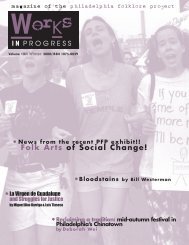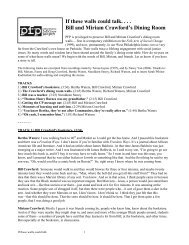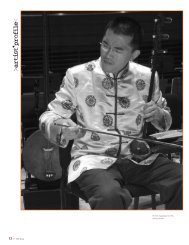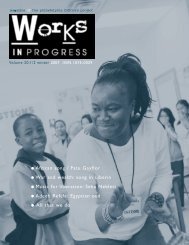View PDF - Philadelphia Folklore Project
View PDF - Philadelphia Folklore Project
View PDF - Philadelphia Folklore Project
- No tags were found...
Create successful ePaper yourself
Turn your PDF publications into a flip-book with our unique Google optimized e-Paper software.
ject. Because as a senior, you had todo a recitation or whatever. Andmost people would do scenes fromplays. And again, me and my avantegardeunorthodox self, I got upthere and did a whole thing of storytelling,telling stories, singing.But that kind of led me moreinto the storytelling and into thefolktales. Because I had been in thePunch Out just sharing stories fromhome, you know, about ‘splo and allthat kind of stuff. And I thougheverybody knew what ‘splo was.Because ‘splo was like home-brew,home-made liquor, you know. And Ithink the reason it was called‘splo- because that was like short forexplosion. And once you taste it—well, just the smell would knockyou. … So when I would talk aboutwhat was going on down inTennessee at the Punch Out someof the people were shocked.Because some of the people whocame to Howard at that time wereconsidered like the light bright.They came from the middle class.Their parents were like judges andlawyers and doctors and all of that.So some of the stuff I was sharing—some of them were embarrassed byit. Some of them had never heardof it.So a lot of these elements werekind of bursting out of me. And like Isaid, they kind of reached a head withme at Howard, with me still liking theaterbut kind of merging them together.And then I remember when myhusband, Clay, was a teacher there.And you had black poets, you hadblack dramatists, you had all this stuff,you know black, black, black, black,black, but there was nothing in termsof black storytelling, in terms of preservingthe folktales.And Stephen Henderson, he haddeveloped something called theInstitute for the Arts and Humanities.And he is really the one that startedbringing all the different Black Artstogether. Because, like I said, theBlack Arts Movement really cameout of the poetry and the plays. Andit was really almost like a Black malemovement, too. You had peoplesuch as Sonia Sanchez, who is oneof the people who emerged, but itwas really dominated by the men,you know. And they were going tohave this program and they wantedit to reflect all of the black arts. AndStephen Henderson was the onewho said, “You know, we need storytelling.We need a storyteller.” Andthat’s the first time that that ideaclicked in my head. And my husbandwas teaching in the departmentat the time, and he thought ofme, because I was telling stories, Iwas telling stories to him, I wastelling stories to my kids. So hecame home and he said, “Linda,” hesaid, “They’re looking for a storyteller.”And I said, “Well, here I am.”And that’s how I started, really.But that first program that I did.I think I told a story about BuhRabbit and I think I even did anAesop fable. I was just doing whateverI had been telling my kids. AndI remember I had all these cloths,and after I had done everything, itwas like people were just staring atme. It was like they had never seenanything like that before, just staring.I didn’t know if they liked it orwhat they felt. But then they comeup to me and they hugged me, andthey said, “Wow this is just unbelievable,this is something.” So fromthere, I said, well, this is what I’mgoing to do now. This is it. I’vefound my calling. Because that wasthe thing, trying to find your calling.So this was it.And being at Howard and beingat those times, I thought of storytellingas a political statement. Andthat’s where I come out of it. Like Isaid, I come out of the Black Artsand Black Power movement, and Iwanted to make a political statement.So I would use storytelling.And I would say “ancient tales fornew times.”And my audiences at the timewere adult. You know, because astory is an animal story, they tend tothink it is a story for children, but itis a story for everybody. So I wastelling these animal stories, but theywere really for the adults. And Iwould tell a story that almost kindof had a political thing to it. In otherwords, a person had to figure it outfor themselves, but the wholepower of a fable, of an animal storyis that even though you’re talkingon an animal, it’s taking on humancharacteristics. Also, you have toremember, this was a time duringthe Vietnam War. There was allkinds of things going on during thattime. So my stories tended to befables and animal stories but theywere stories again to kind of wakeup people. To kind of excite thecrowd, you know, to get people toreact, to express themselves. Andduring the 60s and 70s, you couldsay pretty much anything you wantedto say. There was no censorship,like there is now.And you’d hear all kinds ofstuff, and I remember Leroi Jonescoming to Howard’s campus, oncampus. They would do programson the steps, and he did this fabulousprogram. Nowadays we wouldcall it spoken arts, poetry, or thattype of thing. In those time, it didn’treally have a title. But to hear LeRoiJones do his poem “Up against thewall”…It was like nothing I had everheard before in my life! And he andhis manner, his mannerisms had theelements of what I would call storytelling.Because Leroi Jones woulddo his poetry to get the word out.In other words, he did whatever hecould to get the word out. He mightbe hollering or screaming or stompingand all that kind of stuff. Andthat’s the kind of stuff I wanted todo. So storytelling kind of gave methat outlet, where I could mimicpeople. Because I loved the idea ofmaking faces, I loved the idea ofmimicking people….I didn’t know that that was consideredan African way of telling astory. I was just telling a story thebest way I knew how. My influences—Imean coming from mymother, my father, my grandfather,you know, my aunts and uncles, the[Continued on page 21➝]Photo: Linda Goss and relativeson a rare snowy dayin Tennessee, c. late 1950searly1960s. Photos courtesyof artist.15














